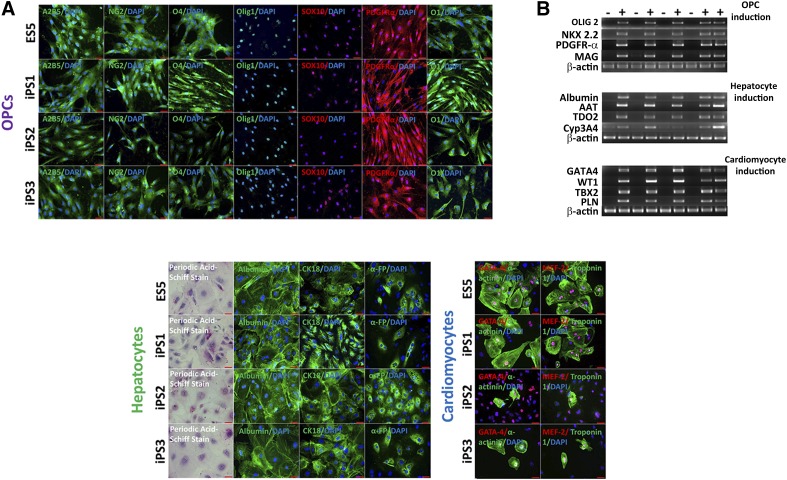Figure 4.
Immunocytochemical and reverse transcription-polymerase chain reaction-based characterization of fully differentiated clinically relevant human pluripotent stem cell derivatives. (A): Immunostaining of specific human embryonic stem cell (hESC) and human induced pluripotent stem cell (hiPSC) lines differentiated into three clinically relevant cell types representative of all three germ layers. Top four rows, left to right: OPC (ectoderm) stained with A2B5 (green), neural/glial antigen 2 (green), O4 (green), OLIG1 (green), SOX10 (red), PDGFR-α (red), and O1 (green). Bottom left four rows, left to right: Hepatocytes (endoderm) stained for glycogen synthesis with periodic acid-Schiff stain (pink), albumin (green), cytokeratin 18 (green), and α-fetoprotein (green). Bottom right four rows, left to right: Cardiomyocytes (mesoderm) were stained with GATA4 (red) and α-actinin (green) and myocyte enhancer factor-2 (red) and troponin-1 (green). Scale bars = 50 µm for OPCs, hepatocytes, and cardiomyocytes; scale bars = 100 µm for periodic acid-Schiff stain. (B): Reverse transcription-polymerase chain reaction (PCR) analysis confirmed the expression of lineage-specific genes for differentiated cell types: OPCs (OLIG2, NKX2.2, PDGFR-α, and MAG), hepatocytes (albumin, AAT, TDO2, and Cyp3A4), and cardiomyocytes (GATA4, WT1, TBX2, and PLN). All PCRs were run with β-actin control. Abbreviations: AAT, α1-antitrypsin; Cyp3A4, cytochrome P450; DAPI, 4′,6-diamidino-2-phenylindole; ES, human embryonic stem cell line; GATA-4, GATA binding protein; iPS, induced pluripotent stem; MAG, myelin-associated glycoprotein; NK2.2, NKX homeobox 2; OLIG, oligodendrocyte transcription factor; OPC, oligodendrocyte progenitor cell; PDGFR-α, platelet-derived growth factor receptor-α; TDO2, tryptophan 2,3-dioxygenase.

